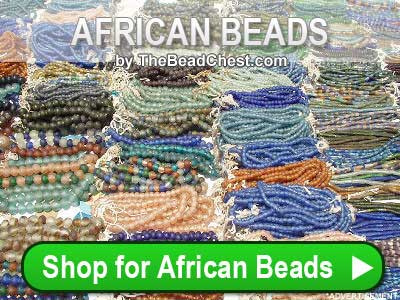Glass Beads have long had their place in Ghanaian culture, but it wasn’t until relatively recently that artisans in the region began producing them in their own right. The glass-making revival began in the 1950s when, faced with the prospect of severe poverty, several artisans among the Asante and Krobo tribes decided to pool their bead-making talents, and begin producing glass beads on a massive scale. These small co-operatives paved the way for a multi-million dollar economy in this small corner of Ghana, which has since become known as the bead-making hub of West Africa.
For me, an inherent part of the appeal of Recycled Glass Beads is their similarity to the Venetian Trade Beads of old. From spotted eye beads popular during the 19th Century, to the more recent White Heart Beads produced in the early 20th Century, the people of Ghana have a knack for reproducing uncanny imitations with relatively basic tools and materials. But, while nearly all beads are made using the old powder-glass casting technique, there are three distinctive styles that set them apart.
Bodom Beads
Bodom Beads are sand-cast beads once produced exclusively for tribal leaders. They are typically larger than most other types of Recycled Glass Beads, and like old Venetian White Hearts, comprise a yellow core enveloped by an outer layer of glass. Bodom Beads usually feature a diamond shape on the outer skin, created by layering glass powder of different colors in a bead mold.
Painted Glass Beads
Otherwise known as Fancy Powder Glass Beads, these are beads which have been skilfully hand-painted to make them look like old Trade Beads. Painted glass beads are typically smoother than plain Recycled Glass Beads because they are tumbled several times when cooled. Traditionally, they would be painted using vegetable dyes, however, most designs are now painted on with colored glass frit. The beads then undergo a second stage of firing to anneal the outer layer.
Translucent Beads
Translucent Recycled Glass Beads are the most common variety produced by the Krobo and Asante. They are often likened to sea glass beads because of their rustic, eroded aesthetics. This is achieved by tumbling the beads in a mix of sand and water to age the outer layer. Genuine Krobo beads are usually two-tone in color, with no visible seam.

 African beads, trade beads, and antique beads have been enjoyed by many for centuries. African beads are treasured for their history. Many have traveled over 3 continents and can be up to centuries old. This blog is devoted to providing you with accurate information on African beads, trade beads, and antique beads. We hope you enjoy our blog!
African beads, trade beads, and antique beads have been enjoyed by many for centuries. African beads are treasured for their history. Many have traveled over 3 continents and can be up to centuries old. This blog is devoted to providing you with accurate information on African beads, trade beads, and antique beads. We hope you enjoy our blog!